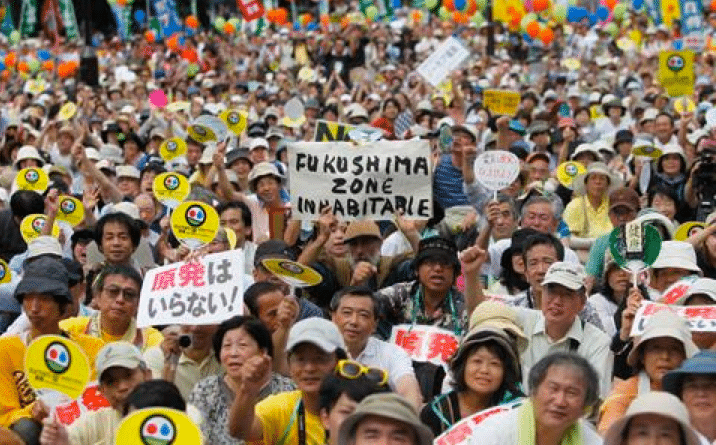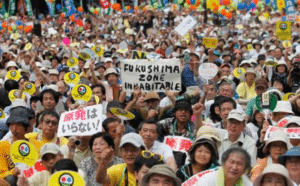(Re-)Creating Nuclear Fuel Demand in East Asia
South Korea, Japan and Taiwan, three historically large markets for uranium and fuel cycle services, have been under siege by organized antinuclear opponents who have made the most from Fukushima to rally public support for their efforts.
To paraphrase a cliché, nuclear energy opponents did not let an attention-getting crisis go to waste. As a result of the traditional reluctance by nuclear energy supporters to speak up, the antis have been largely unopposed.
From its recently opened office in east Asia, Greenpeace International has issued a torrent of news releases and messages designed to stoke fear and distrust. They’ve sponsored widespread screenings for a disaster movie about a fictional event at a nuclear plant.
Here is a sample quote from a March 2017 (fundraising?) article on Greenpeace’s web site:
“The 2011 Fukushima Daiichi nuclear catastrophe may feel like ancient history in a world constantly bombarded with news of another tragedy or disaster. But for those who were impacted by the worst nuclear disaster in a generation, the crisis is far from over. And it is women and children that have borne the brunt of human rights violations resulting from it, both in the immediate aftermath and as a result of the Japan government’s nuclear resettlement policy.”
So far, their efforts have succeeded, probably beyond their initial hopes and goals.
Japan has about 40 operational reactors that have not operated since 2011.
Three of Taiwan’s six reactors have been shutdown for an indefinite period of time and the country passed a law in January mandating a nuclear-free grid by 2025.
South Korea elected a president in July who pledged to halt new reactor construction, to prevent license renewals and to phase out nuclear energy completely.
Each of the nations have nuclear plant construction projects that are currently stalled by government direction.
There are reasons to hope that the war is not lost, even though the battle toll has been quite severe with the good guys on the losing side most of the time.
With a moderate investment in a well-designed strategic marketing campaign, the fuel cycle industry has an opportunity to rebuild a substantial customer base. Success in that effort may sway hearts and minds outside of Asia.
Atomic Insights does not consume your bandwidth or degrade your experience by running ads.
We encourage everyone to read our stories and discuss them civilly in our moderated forum.
South Korea’s Small Victory
A fee weeks ago, a South Korean citizens’ panel recommended a reversal of President Moon Jae-in’s decision to stop building Shin Kori units 5 and 6.
The 471-member panel decided, with a vote tally of 60% in favor of continuing and 40% supporting the halt, that the projects should be finished and operated.
It did not, however, provide a rousing endorsement for nuclear energy. A small majority of the members indicated that they supported the plan to gradually phase it out.
But those who supported continuing were convinced that it would be better for the country to complete projects for new reactors for which components had already been purchased and $2 billion had already been spent or committed.
Members accepted evidence that finishing the construction projects would put several thousand people back to work and mitigate the imposed economic harm to the host community.
Ulsan, the host community, had already made investments in infrastructure to support the facility and the construction work force. Its businesses and tax base had been significantly damaged by the abrupt work stoppage.
Completing the APR-1400s would also allow a nuclear phase out that maintained modern facilities in preference to older facilities with fewer safety enhancements. Continuing new construction would support KEPCO’s ongoing efforts to land additional international customers.
Korean opposition to nuclear energy continues to be politically strong. It seems to be relatively free to use emotional arguments without sufficiently being challenged by similarly framed arguments in favor of nuclear energy as the cleanest, most abundant, most affordable and safest available option.
While accepting the panel’s recommendation to complete the two Shin Kori units, President Moon reiterated his promise to his political base that he remains committed to shifting the electricity system to consume more natural gas and build more renewables.
Attention Getting Warning In Taiwan
Like South Korea, Taiwan is a small, resource-poor, isolated, export-dependent nation that logically invested in nuclear energy. It has three two-unit nuclear plants and a fourth under construction.
Three of the six operational reactors are currently closed for political reasons, while the new plant construction project has been halted since 2014 even though nearly complete. Nuclear opponents feel that they have a working majority of support from the public and plan to press forward with a complete exit from the technology by 2025.
In August, Taiwan’s public received a warning about the economic risk associated with an unbalanced and inadequately resilient grid.
A technician working on the gas supply system made an error that interrupted the flow of fuel to a large, six-unit natural gas fired station. The interruption lasted only two minutes, but it tripped all six generators and instigated a widespread power outage affecting more than 6 million customers. That outage lasted for more than five hours.
That event is an example of expensively identifying a fragile system with a single point failure vulnerability.
A series of somewhat less dramatic events have raised public awareness about the fragility of the island nation’s power system and have caused some to question the logic behind the policy of closing operational nuclear units.
A recent article in the Taipei Times that described a recent forum on nuclear energy featuring Environmental Progress’s Michael Shellenberger included the following statement.
“There used to be a tug-of-war between pro and anti-nuclear groups, but the anti-nuclear camp has gained favor ever since the 2011 Fukushima Daiichi disaster in Japan, former Environmental Protection Administration minister Wei Kuo-yen said in the first panel discussion with Shellenberger.” (Emphasis added)
The recent power supply disruptions offer pronuclear forces a timely opportunity to make its case to a public that may be especially willing to listen. A public and a business community faced with the negative impacts of power shortages should be encouraged to join the pronuclear forces and powerfully drag the rope in the right direction.
Several independent pronuclear activists are doing what they can to help Koreans, Japanese and Taiwanese understand that their nations need nuclear in order to grow and prosper.
Their efforts could be far more successful if aligned–but not co-ordinated with–a marketing campaign designed to sell nuclear energy to the public as a superior wealth and health enhancing power source.
When the citizens and businesses of the three Asian tigers recognize what they are being asked to sacrifice in order to appease a vocal minority, the demand for uranium and fuel cycle services should recover rather quickly.
Note: A version of the above was first published in Fuel Cycle Week, an industry newsletter that focused on the front end of the nuclear industry.



Rod , you began with the key point , the traditional reluctance of pronuclear suporters to speak out.
I agree with your proposal about the need for a marketing campaign but to make that work it needs three things , the vocal support of pronuclear community , the strong guidance of the pronuclear leadership and money. Get the first two and the money will follow.
Why don’t the supporters speak out ? Do they lack a sense about how to proceed ? That would clearly be a leadership issue. Are they educated enough to talk to the public about the issues assuming the did have a road map formulated ? Throwing this to a marketing firm with out vocal support and strong leadership would be a waste of money. The firm are not nuclear advocates , they most likely produce a ineffective result. Thank you for your time.
@Donald Ernst
You make some good points. However, this article was written for the target audience of people in the nuclear fuel cycle business. As businessmen – ostensibly – they have a responsibility to learn how to best present their product and to find more customers eager to purchase it. That is part of running a business, especially a publicly traded business with stockholders who have put their faith into the managers they have hired.
With regard to marketing, the NEI has recently developed a number of excellent commercials as part of a campaign that just needs some additional funding to make it spread outside of the Washington D. C. beltway. Ad Campaign Touts Marvels Of Atomic Technology With Tagline ‘Nuclear. Power The Extraordinary’.
The industry needs to break out of its traditional, silent service influenced, mode of doing business. Leaders need to understand that they are in a competitive market with many energy alternatives. If they want to grow or even simply protect what they have, they need to break out of their cones and silos and figure out how to persuade the public that their product is valuable and worth purchasing.
(Yeah, I know that the public does not buy power plants directly, but they sure do influence the purchase decision.)